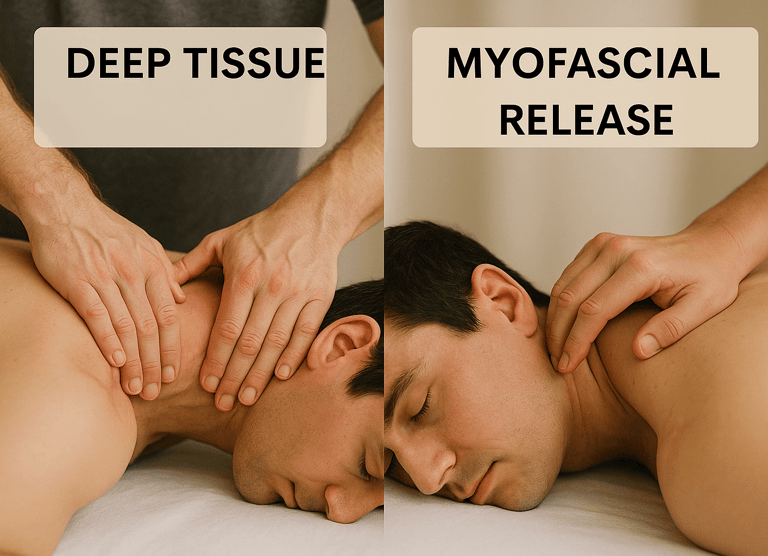Deep Tissue vs. Myofascial Release: Choosing Your Pain Relief Massage
Confused about Deep Tissue vs. Myofascial Release? Learn the differences between these powerful therapeutic massages to find the best approach for your chronic pain, stiffness, and recovery needs.
Unknow
7/2/20252 min read


Decoding Your Pain: When to Choose Deep Tissue vs. Myofascial Release
That persistent ache in your shoulder, the tightness in your hip, or the nagging discomfort in your neck – pain can be complex, and finding the right solution often feels like decoding a mystery. When it comes to therapeutic massage, two powerful modalities, Deep Tissue Massage and Myofascial Release, are often recommended for chronic pain and stiffness. But while both aim to alleviate discomfort, they approach the body in distinct ways. Understanding the difference can help you choose the best path to relief.
Deep Tissue Massage: The Focused Muscle Work
Imagine your muscles are like a bundle of ropes. Overuse, injury, or poor posture can cause these ropes to become tangled, knotted, and stiff. Deep Tissue Massage is like a skilled hand meticulously untangling and smoothing out those ropes.
What it targets: Primarily focuses on the deeper layers of muscle tissue and tendons.
How it works: Your therapist uses slow, sustained strokes, applying intense, focused pressure with fingers, thumbs, elbows, or forearms. The goal is to break down adhesions (scar tissue), release chronic knots, and alleviate deeply held tension.
What it feels like: It can be intense, sometimes even a bit uncomfortable, as the therapist works through resistant tissue. However, it should never be excruciating. Communication with your therapist is key.
Best for:
Chronic muscle pain (e.g., in the lower back, neck, shoulders).
Muscle knots and trigger points.
Recovery from muscle strains and sprains.
Postural problems stemming from tight muscles.
Individuals who prefer firm pressure and can tolerate intensity for deeper release.
Myofascial Release: The Gentle, Sustained Fascial Unwinding
Now, imagine your entire body is encased in a continuous, thin, web-like suit of connective tissue called fascia. This fascia surrounds every muscle, bone, nerve, and organ. When this "fascial suit" becomes tight, stiff, or "bound down" from injury, inflammation, or repetitive stress, it can create immense pressure on pain-sensitive structures, even far from the original site of restriction. Myofascial Release (MFR) works to gently unwind this fascial suit.
What it targets: Primarily focuses on the fascial system, which can restrict muscles and organs.
How it works: MFR involves applying gentle, sustained pressure (often very light) and stretching to the restricted areas of fascia. The therapist holds the stretch for several minutes (typically 3-5 minutes or more) to allow the fascia to soften and release. No oils are used, allowing direct engagement with the tissue.
What it feels like: It's often described as a subtle pulling or stretching sensation, sometimes with a feeling of "melting" or "unwinding" as the tissue releases. It's generally much gentler than deep tissue, though the release can be profound.
Best for:
Chronic pain that doesn't seem to respond to traditional massage.
Fibromyalgia.
Headaches and migraines.
TMJ dysfunction.
Restricted range of motion due to fascial tightness.
Individuals who prefer a lighter, more subtle touch but seek deep, lasting release.
Choosing Your Path to Relief
Both Deep Tissue Massage and Myofascial Release are powerful therapeutic tools. The "best" choice depends on the nature of your pain and your personal preference:
If your pain feels localized, deep, and like a "knot" in the muscle, and you prefer firm pressure, Deep Tissue might be your starting point.
If your pain feels more widespread, burning, or restrictive, and you prefer a gentle, sustained approach, Myofascial Release could be more effective.
Many therapists are trained in both and may even integrate elements of each into a session. The most important step is to communicate openly with your therapist about your symptoms and goals.
URBAN MASSAGE GUIDE
Your trusted source for massage knowledge and wellness insights.
Have a question or suggestion?
Reach us at: urbanmassage@gmail.com
Quick Links:
© 2025 Urban Massage Guide. All rights reserved.
Disclaimer : Urban Massage Guide is built to share knowledge about massage therapy and promote wellness awareness. We respect your privacy and do not share any of your personal information.
